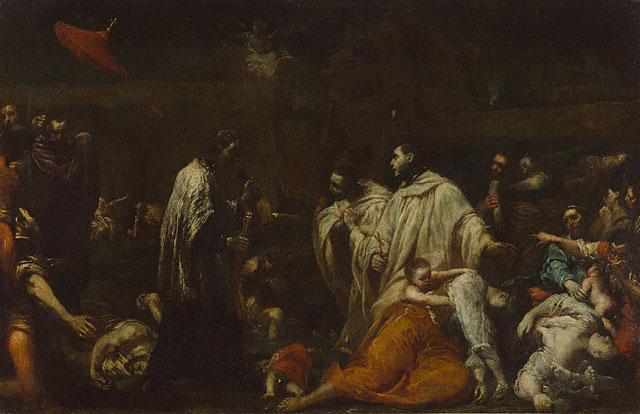It has been a bit of a struggle finding information
to keep this blog going over the course of this semester; this week I tried a
different route and sourced mined some of my previously used sources to see
where some of their information came from. I hope that this strategy will be
useful in keeping my information for my blog/research project from getting
stale.
Last week I discussed the manuscript: Dance Macabre, in graveyard of the church of
St. Magnus at Magdeburg. This manuscript gave the impression of death having
a “personality.” For this week, I want to look at another work of art that
depicts the Black Death.
 "During the Black Death of 1348, the Blessed Bernard Tolomei left the safety of his Benedictine monastery in Monte Oliveto and returned to his native Siena to attend to the sick and dying. He succumbed to the plague that same year and soon became the object of religious devotion. An abbot from Bernard's monastic order commissioned this painting in 1736, when Bernard was being considered for sainthood. Giuseppe Maria Crespi interpreted the story's pathos with great depth, expression, and immediacy." [1]
"During the Black Death of 1348, the Blessed Bernard Tolomei left the safety of his Benedictine monastery in Monte Oliveto and returned to his native Siena to attend to the sick and dying. He succumbed to the plague that same year and soon became the object of religious devotion. An abbot from Bernard's monastic order commissioned this painting in 1736, when Bernard was being considered for sainthood. Giuseppe Maria Crespi interpreted the story's pathos with great depth, expression, and immediacy." [1]
Although much of what I have been researching has
been from manuscripts specifically from the same century as the Black Death, I think
it’s important to understand how much of an impact the Black Death had on
society even three hundred to four hundred years later.
"Wearing a white robe and holding a crucifix, Bernard and a fellow monk attend to plague victims in an open-air encampment outside the walls of Siena. On the left, a priest walks under an umbrella, accompanied by an acolyte. Several plague-stricken figures languish on the ground in various stages of death. Below Bernard, a woman slumps over while her small child desperately tries to pull her upright. At her feet, the foreshortened body of a dead infant falls in the area between the acolyte and bowing monk. A woman has perished in the right corner, her gray-skinned body lifeless, thus a man above her holds a cloth over his mouth to avoid smelling the stench. Contorted, highlighted figures emerge from the shadowy darkness to confront the viewer, accordingly heightening the emotion of the drama. " [1]
Like Dance Macabre, Bernard Tolomei and the Plague in Siena gives death a “personality”, yet one that is three hundred – four hundred years later. The “personality” in this painting is different from that of the Dance Macabre; mentioned in some of my previous blog entries, Benard Tolomei and the Plague in Siena exhibits traits that represent the overall feelings of society during the Black Death. Death and dying is depicted as a very real feeling; in Bernard Tolomei and the Plague in Siena, images of the dead and dying strewn out into the street, and death is stalking its victims.
What I find most important about this work is the fact that even as late as 1736; society still feared the death and particularly the plague. There is absolutely no comparison with this work of art with manuscripts from before the plague. The dark themes and the presence of death can be felt, this leads me to believe that the Black Plague’s reign of fear did not end with eradication rather it plagued humanity for many years after.
[1] The J. Paul Getty Trust . "Bernard Tolomei and the Plague in Siena (Getty Museum)." Bernard Tolomei and the Plague in Siena (Getty Museum). http://www.getty.edu/art/gettyguide/artObjectDetails?artobj=904 (accessed October 28, 2013).
No comments:
Post a Comment